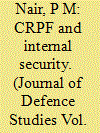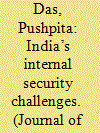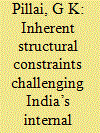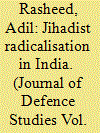| Srl | Item |
| 1 |
ID:
158835


|
|
|
|
|
| Summary/Abstract |
This article critically analyses the strengths and weaknesses of the Central Reserve Police Force (CRPF), as the prime agency of the Government of India, attending to manifold matters of internal security. Many incidents, including classic achievements as well as downsides are presented here. The article highlights the need for a functional audit, urgency in professionalising the personnel, harnessing human potential in the best manner and the role of research and development. Another pertinent aspect brought out is a paradigm shift in the selection of leadership, with justification and the process involved in it. The intimate and intricate in-house aspects of the force have also been covered cogently.
|
|
|
|
|
|
|
|
|
|
|
|
|
|
|
|
| 2 |
ID:
158824


|
|
|
|
|
| Summary/Abstract |
On 8 July 2016, a group of soldiers and policemen surrounded a house in Bumdoora village of south Kashmir. As search of the house started, one policeman was fired at and injured. By the time the encounter ended three terrorists had been killed; one of them was Burhan Wani, a Hizbul Mujahideen leader. Following the killing, Kashmir erupted in a wave of protests.
|
|
|
|
|
|
|
|
|
|
|
|
|
|
|
|
| 3 |
ID:
158826


|
|
|
|
|
| Summary/Abstract |
This article looks at the essential conditions for a durable peace in Kashmir and argues that the Valley has been most peaceful only during an active, on-going peace process. The lack of effective and continuous engagement with key stakeholders, especially the people of Jammu and Kashmir (J&K), has fostered a sense of deep alienation and enduring distrust. It further argues that counterinsurgency operations need to be simultaneously augmented by an active peace process engaging all stakeholders. This would mean a dialogue between the Centre and the J&K and Mainstream and Separatist parties as well as between the different regions of the state. The different political attitude in the Valley, Jammu and Ladakh can serve as a roadblock to a lasting peace if a dialogue is not underway. It recommends urgent steps that must be taken to regain the confidence of people and move closer towards resolution of the conflict.
|
|
|
|
|
|
|
|
|
|
|
|
|
|
|
|
| 4 |
ID:
158816


|
|
|
|
|
| Summary/Abstract |
India has been facing multiple internal security challenges for more
than 60 years. These challenges have assumed five forms: ethnic/
tribal insurgencies in the North-East variously demanding secession
or autonomy; left-wing extremism (LWE) seeking to overthrow the
democratic political system; militancy arising out of perceived politicoreligious
grievances in Punjab; a combination of an insurgency actively
fuelled by Pakistan and terrorism perpetrated by Pakistani terrorist
groups in Jammu and Kashmir (J&K); and Islamist terrorism in the
hinterland. Despite sustained police/military operations as well as social,
economic and political measures to address perceived grievances and
empower estranged sections of the populations in these areas, many or
most of these challenges have continued to persist. These internal security
challenges have endured, and sometimes increased, due to a combination
of factors unique to each case.
|
|
|
|
|
|
|
|
|
|
|
|
|
|
|
|
| 5 |
ID:
158821


|
|
|
|
|
| Summary/Abstract |
The words ‘internal security’ do not figure in the Constitution of India. At the time of the framing of the Indian Constitution, the lawmakers were more worried about preserving the unity and sovereignty of the new nation. The world was in a far more peaceful environment and issues like terrorism and cybersecurity were far from their minds. Their outlook was conditioned by the constitutions then in existence. The thought was that all law and order situations could be handled by the state governments and the role or duty of the Union government (Article 355) was to protect the states from external aggression and internal disturbances and to ensure that governance is carried on in accordance with the provisions of the Constitution.
|
|
|
|
|
|
|
|
|
|
|
|
|
|
|
|
| 6 |
ID:
158834


|
|
|
|
|
| Summary/Abstract |
The Indian strategic community has for long debated aspects of jihadist radicalisation in the country—particularly over its origins, causes, extent, trajectory and possible counter-measures. This article posits that in the absence of clear perspectives, the incipient threat of jihadist radicalisation has the potential to metastasise and snowball quickly, as has been witnessed in other parts of the world in recent times. Currently, there are three strands of jihadist radicalisation seeking to influence Indian minds, namely, homegrown radicalisation, cross-border radicalisation and the global jihadist radicalisation of transnational groups like al-Qaeda and the Islamic State of Iraq and Syria (ISIS). Although all the three forms have different strategic orientation and goals, they often collude to administer a heady brew to impressionable minds vexed by the country’s several socio-cultural, economic and political challenges.
|
|
|
|
|
|
|
|
|
|
|
|
|
|
|
|
| 7 |
ID:
158833


|
|
|
|
|
| Summary/Abstract |
This article shows that the Maoists have been collecting not less than Rs 140 crore annually from a variety of sources: businesses—big and small—industry; contractors engaged in various trades; corrupt government officials; and political leaders. The largest and principal sources of income for the Maoists are the mining industry, PWD works, and collection of tendu leaves. They have been able to put in place a well-organised mechanism to extort money on a regular basis. Besides, they have conceived ingenious ways to store money and ensure its safety. Even as they have issued guidelines for the collection of money, the Maoists have, similarly, also circulated guidelines on expenditure and maintaining fiscal discipline. It is not possible to bottle up Maoist extortion. However, many measures can be taken to contain it.
|
|
|
|
|
|
|
|
|
|
|
|
|
|
|
|
| 8 |
ID:
158832


|
|
|
|
|
| Summary/Abstract |
The Naga quest for independence is one of the longest-running struggles in the Indian subcontinent. Despite numerous attempts made in the past towards resolving the conflict, it continues to remain elusive on account of various fault lines. The signing of a ‘Framework Agreement’ between the National Socialist Council of Nagalim–Issak and Muivah (NSCN-IM) and the Government of India in August 2015 was one such attempt. However, the views of various stakeholders remain fragmented as the details of the agreement have not been disclosed in the public domain. Existent challenges and changing aspirations of the Naga populace necessitate a different approach towards resolving the Naga conflict.
|
|
|
|
|
|
|
|
|
|
|
|
|
|
|
|